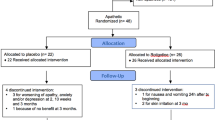Abstract
Apathy is a common neurobehavioral symptom of other syndromes or a syndrome per se which occurs in a variety of neuropsychiatric disorders. Apathy depends on disruption of emotional, cognitive, and behavioral functions. Six brain-damaged patients were assessed, including five patients with unilateral or bilateral focal lesions of the basal ganglia or the thalamus (showing apathy due to an auto-activation deficit) and one patient with bilateral lesions in the limbic temporomesial cortex associated with a form of emotional-affective apathy. A significant and persistent improvement of apathy was observed in all patients after treatment with dopamine agonists such as pramipexole, ropinirole, and rotigotine. These results confirm preliminary reports on the beneficial effects of dopamine agonist agents on apathy and suggest that this syndrome can be treatable in many cases.

Similar content being viewed by others
References
Marin RS (1991) Apathy: a neuropsychiatric syndrome. J Neuropsychiatry Clin N 3:243–254
Levy R, Dubois B (2006) Apathy and the functional anatomy of the prefrontal cortex-basal ganglia circuits. Cereb Cortex 16:916–928
Marin RS (1990) Differential diagnosis and classification of apathy. Am J Psychiatry 147:22–30
Stuss DT, Van Reekum R, Murphy KJ (2000) Differentiation of states and causes of apathy. In: Borod JC (ed) The neuropsychology of emotion. Oxford University Press, Oxford, pp 340–363
Eslinger PJ, Damasio AR (1985) Severe disturbances of higher cognition after bilateral frontal lobe ablation: patient EVR. Neurology 35:1731–1741
Bathia KP, Marsden CD (1994) The behavioural and motor consequences of focal lesions of the basal ganglia in man. Brain 117:859–876
Habib M (2004) Athymhormia and disorders of motivation in basal ganglia disease. J Neuropsychiatry Clin N 16:509–524
Pigliautile M, Ricci M, Mioshi E et al (2011) Validation study of the Italian Addenbrooke’s Cognitive Examination Revised in a young-old and old-old population. Dement Geriatr Cognit Disord 32:301–307
Beck AT, Ward CH, Mendelson M et al (1961) An inventory for measuring depression. Arc Gen Psychiatry 4:561–567
Marin RS, Biedrzycki R, Firinciogullari S (1991) Reliability and validity of the apathy evaluation scale. Psychiatry Res 38:143–162
Mega MS, Cummings JL (1994) Frontal subcortical circuits and neuropsychiatric disorders. J Neuropsychiatry Clin N 6:358–370
Fuster JM (2008) The prefrontal cortex, anatomy, physiology, and neuropsychology of the frontal lobe. Academic Press, New York, pp 1–424
Levy R (2012) Apathy: a pathology of goal-directed behaviour: a new concept of the clinic and pathophysiology of apathy. Rev Neurol 168:585–597
Missale C, Nash SR, Robinson SW et al (1998) Dopamine receptors: from structure to function. Physiol Rev 78:189–225
Barrett K (1991) Treating organic abulia with bromocriptine and lisuride: four case studies. J Neurol Neurosurg Psychiatry 54:718–721
Marin RS, Fogel BS, Hawkins J et al (1995) Apathy: a treatable syndrome. J Neuropsychiatry Clin N 7:23–30
Powell JH, al-Adawi S, Morgan J, Greenwood RJ (1996) Motivational deficits after brain injury: effects of bromocriptine in 11 patients. J Neurol Neurosurg Psychiatry. 60:416–421
Reichmann H, Bilsing A, Ehret R et al (2006) Ergoline and non-ergoline derivatives in the treatment of Parkinson’s disease. J Neurol 253(Suppl 4):IV36–IV38
Conflict of interest
I certify that there is no actual or potential conflict of interest in relation to the article.
Author information
Authors and Affiliations
Corresponding author
Rights and permissions
About this article
Cite this article
Blundo, C., Gerace, C. Dopamine agonists can improve pure apathy associated with lesions of the prefrontal-basal ganglia functional system. Neurol Sci 36, 1197–1201 (2015). https://doi.org/10.1007/s10072-014-2061-5
Received:
Accepted:
Published:
Issue Date:
DOI: https://doi.org/10.1007/s10072-014-2061-5




